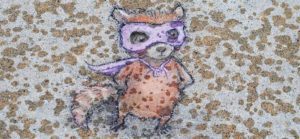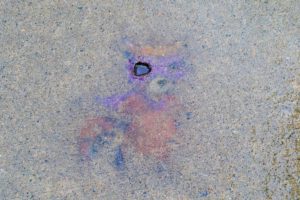When Lula June Cook told David Zinn, “You need a TikTok,” he said to himself, “Well, she’s never steered me wrong before.”

Zinn at work at the Ann Arbor Summer Festival in June—and the aftermath. Doing your best work, only to see it disappear when a latte or a sudden rainstorm descends, “definitely puts you in a mind of knowing that everything is temporary, because everything is,” he says. | Photo by J. Adrian Wylie
The artist, who’s fifty-two, and his “most trusted advisor,” twelve, met on Bach Elementary’s “big playground” in 2015. Zinn was painting a mural there when “this little girl appeared, announced that she was Queen of the Playground, and I was her friend now, and under her protection.”
Lula June helped him paint the mural—the part she could reach—and when it was vandalized, her mom, Amy Cook, was among the volunteers who helped him restore it. “It got hit several times after that on a smaller scale,” she recalls, but “armed with graffiti-removal spray and a scrub brush,” they preserved it.
That’s unusual for Zinn’s work—not because of the community’s kindness, but because most of his art is deliberately ephemeral.
Zinn admits to a “strange fondness” for urban “carelessness and decay.” He’ll start with a crack in the sidewalk, a rusted utility cover, or a tuft of grass, and draw a scene featuring characters like Nadine, “the mouse of adventure,” winged Philomena, “the patron pig of impossibility,” and Sluggo, “the monster with an eye for trouble.” From the right vantage point, they’re three-dimensional—but because he works in chalk, they’re gone in the first rainstorm.
Several years ago, Zinn created a website to sell books, prints, and postcards of his underfoot artwork. Until his “most trusted advisor” suggested it, though, it hadn’t occurred to him to make videos showing how they came to life. On Lula June’s advice, he downloaded the app, and “immediately went to my teenage nephew to explain how TikTok works.”
That was last summer. Since then, Zinn has posted more than 150 videos on TikTok (@StreetArtByDavidZinn). They’ve been “liked” 22.8 million times. The most popular one—“Myron Feeney, Sidewalk Stylemaker,” in which Zinn turns a patch of cracked concrete outside the Pretzel Bell into a #Dapper #Goblin—has been viewed 11.1 million times.
—
Ask Zinn to draw a still life, or a portrait, and he says he can’t do it. “I can’t draw cars. I can’t copy things,” he says. What he can do is doodle. He’s been doing it since he was a kid, growing up in a house in the woods between Whitmore Lake and South Lyon.
His father, Karl Zinn, “always had pieces of paper and pens and pencils in his shirt pocket,” Zinn recalls. When David and his older brother, Fred, got bored, he would give them a couple sheets of paper. They’d start a “doodle battle,” taking turns expanding each other’s scribbles into images and creatures.
The “battle was not against each other,” he writes in the introduction to his new book, Chance Encounters: Temporary Street Art by David Zinn. “We were fighting against our own insecurities, and the intimidation of the perfect blank page.”
These days, his doodle battles are with the imperfections of the urban landscape. Composed entirely of chalk, charcoal, and found objects, his drawings are improvised on location—from sidewalks in Michigan to a subway platform in Manhattan and street corners in Taiwan and the French Riviera.
As an “incredibly shy, anxious kid,” Zinn says, his doodles started out as a “sort of makeshift way to tend to my mental health.” Their improbable evolution into public art wound through Greenhills School, the U-M Residential College, and Gilbert and Sullivan operettas.
Before they retired, Zinn’s parents both worked at the U-M. Karl Zinn was a research scientist at the Center on Research for Learning and Teaching, while Ann Copley Zinn worked at Inteflex, an interdisciplinary program based in East Quad. When it became clear that the South Lyon public schools didn’t know what to make of the doodling brothers, the parents sent them to Greenhills.
“I was a standard B student,” Zinn says. “I had zero coordination for any kind of athletics … I was still very much trying to cope with being around people by burying my head in my sketchbook.”
But an uncle had given the boys “pads of paper that had comic-book squares pre-marked on them,” so he “started making some really terrible comic strips” and taping them to his locker. By his senior year, people were looking forward to seeing them, and he was invited to choose the locker that would get him the best public exposure. “That level of validation was huge!” he says.
He went on to the Residential College—“a no-brainer because I knew East Quad like the back of my hand, growing up there.” He majored in creative writing, but also covered his dorm-room door with chalkboard contact paper and continued to draw.
He had a children’s radio show, Rug Rat Review, on WCBN, and signed up for a class for non-musicians “who wanted to learn how to sing, or just wanted to feel free enough to sing.” That led to a role in the chorus of Gilbert and Sullivan’s Ruddigore.
That’s when the incredibly shy undergrad realized that he had “agreed to be regularly in a room rehearsing with the most extroverted people you could find anywhere. So I was doodling madly, just to avoid having a conversation.”
The operetta “had ghosts, good scary stuff in it,” he recalls. But the cover of the libretto “was very boring. It was a stock-art picture of a happy couple.” So week after week, trying not to be noticed, he kept “adding monsters around the happy couple, until the whole page was filled with big, scary things peering over their shoulders.”
Then one of the “outgoing types” came up to him and said, “Hey we need a poster for this show.” When Zinn said he didn’t know how to make a poster, the guy responded, “Could we maybe just use that thing which you’re drawing right now?”
“It was revelatory,” Zinn says. That doodled-on libretto became “the very first job I ever got drawing commercial art.”
For the next twenty years, he drew everything from theatrical posters to a recycling comic for the city’s Waste Watcher newsletter to an umbrella-toting alligator logo for the children’s store Mudpuddles.
He was delighted to do it: “I knew exactly what I had to draw, when it had to be finished, and what I’d get paid if I did,” he explains.
But eventually he got restless. Drawing on a computer tablet, he says, “doesn’t get your hands dirty, and it keeps you inside on really nice days.”
—
Zinn can’t pinpoint the year when he began drawing outside, “because the first few times I ran outside to play with chalk, I was playing hooky” from work. But sometime in the early 2000s, he started drawing on his own driveway.
“In contrast to all the commercial art I’d been doing, this art had no reason to exist,” he recalls. “The pointlessness is kind of the point.
“I couldn’t hang it in a gallery. I couldn’t put it in a frame and sell it. I couldn’t even give it to my mom.
“Worrying about all those things had been keeping me from making art. Canvases cost money. Paints cost money.” But chalk is cheap and sidewalks are free—and “there is no learning curve because you already know how to do this from when you were five.”
As a child, he’d pored over “every tiny detail in every corner of every picture” in the books he read—“all of the Maurice Sendaks, all of the Mercer Mayer monsters, all of the Winnie-the-Poohs.” Now that informed his own creations. “It’s just the way my head is wired,” he says. It “all has to go through some weird mental blender before it comes out.”
He began photographing his drawings and posting them on social media partly to share them with Fred: “My brother lives in Massachusetts,” he says. “He was never going to walk down those streets before it rained.”
In 2015, he published a crowdfunded collection, Temporary Preserves: Chalk Art by David Zinn. “It was a good experiment,” he says, “and it did make Chance Encounters possible.”
By the time the pandemic hit, he had a second book, Underfoot Menagerie: More Chalk Art by David Zinn, and the website. “I got very lucky that my online presence was big enough by 2020 that I’m able to make an okay living by selling things from my online store,” he says.
“Professionally I’m a photographer, as weird as that is to say. Because that’s what I sell in books and put on social media. Which means that the actual making of the art remains a completely separate thing.” Chasing attention online, he says, “can only make it harder to operate as an artist and a human being.”
He began sharing single images on early sites like tumblr years ago. But it took the push from Lula June to get him into “TikTok, where photos aren’t even a thing anymore—it’s all videos.”
With camera in one hand and chalk in the other, he takes short clips as he works, then merges them into a time-lapse where the artwork materializes in a matter of seconds. He draws on his radio experience—“the joy of lining up music just so”—to create the soundtrack.



Despite all the online attention, his life and tax bracket haven’t changed.
“TikTok contains a lot of wonderfully supportive communities, but generally speaking, being ‘famous’ on the internet is like having thousands of friends who will never help you move a couch,” Zinn says.
Still, he counts himself “insanely lucky that I’ve found a way to be a professional daydreamer, because I would be terrible at almost every other kind of profession.”
Doing your best work, only to see it disappear when a latte or a sudden rainstorm descends, “definitely puts you in a mind of knowing that everything is temporary, because everything is,” he says.
“As someone who makes art, the spiritual depth is in the making of the art. Keeping it around after [creating it] is a commercial issue, a practical issue.”
Last year, when he was drawing at the Ann Arbor Summer Festival, “shockingly, it didn’t rain every day. As a result, many of my drawings were still there days later, when I was drawing new drawings.
“I was walking past one of them. It was in surprisingly good shape. A woman was walking in the other direction with a tiny child.
“I saw out of the corner of my eye that the child stopped. And she looked at the drawing and laughed a little bit.
“She kept walking. Then she came back, and kneeled down, and rubbed her face on this drawing until it had been completely obliterated. She essentially hugged this drawing to death.
“And honestly, I can’t think of a better way to go.”
I just bought two of your books.. I do love your art and watching the videos of you doing your wonderful little creatures..You have such a gift that is truly magical ..I look forward to your next creation, they come to life when you hold that chalk in your hand… thank you! Emry A.Quinn
Wonderful David. You are a balm 💕
Loved reading all about you and all the good things you do. You are a creative artist with art for a purpose – bringing momentary joy to someone just when they weren’t expecting it. A beautiful soul with great goals for life.
Love, Laura